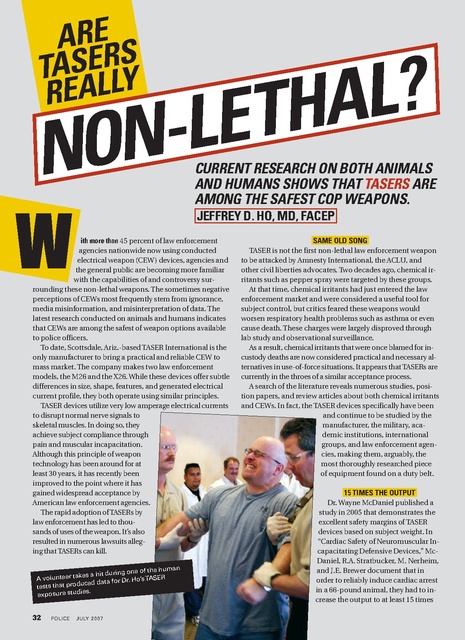Taser Police Magazine Are Tasers Really Non-lethal 2007
Download original document:

Document text

Document text
This text is machine-read, and may contain errors. Check the original document to verify accuracy.
ARE S TASERLY REAL ? L A H T E L N NO W CURRENT RESEARCH ON BOTH ANIMALS AND HUMANS SHOWS THAT TASERS ARE AMONG THE SAFEST COP WEAPONS. JEFFREY D. HO, MD, FACEP ith more than 45 percent of law enforcement agencies nationwide now using conducted electrical weapon (CEW) devices, agencies and the general public are becoming more familiar with the capabilities of and controversy surrounding these non-lethal weapons. The sometimes negative perceptions of CEWs most frequently stem from ignorance, media misinformation, and misinterpretation of data. The latest research conducted on animals and humans indicates that CEWs are among the safest of weapon options available to police officers. To date, Scottsdale, Ariz.-based TASER International is the only manufacturer to bring a practical and reliable CEW to mass market. The company makes two law enforcement models, the M26 and the X26. While these devices offer subtle differences in size, shape, features, and generated electrical current profile, they both operate using similar principles. TASER devices utilize very low amperage electrical currents to disrupt normal nerve signals to skeletal muscles. In doing so, they achieve subject compliance through pain and muscular incapacitation. Although this principle of weapon technology has been around for at least 30 years, it has recently been improved to the point where it has gained widespread acceptance by American law enforcement agencies. The rapid adoption of TASERs by law enforcement has led to thousands of uses of the weapon. It’s also resulted in numerous lawsuits alleging that TASERs can kill. man g one of the hu kes a hit durin R SE TA A volunteer ta ’s Ho . uced data for Dr tests that prod s. ie ud exposure st 32 POLICE JULY 20 07 SAME OLD SONG TASER is not the first non-lethal law enforcement weapon to be attacked by Amnesty International, the ACLU, and other civil liberties advocates. Two decades ago, chemical irritants such as pepper spray were targeted by these groups. At that time, chemical irritants had just entered the law enforcement market and were considered a useful tool for subject control, but critics feared these weapons would worsen respiratory health problems such as asthma or even cause death. These charges were largely disproved through lab study and observational surveillance. As a result, chemical irritants that were once blamed for incustody deaths are now considered practical and necessary alternatives in use-of-force situations. It appears that TASERs are currently in the throes of a similar acceptance process. A search of the literature reveals numerous studies, position papers, and review articles about both chemical irritants and CEWs. In fact, the TASER devices specifically have been and continue to be studied by the manufacturer, the military, academic institutions, international groups, and law enforcement agencies, making them, arguably, the most thoroughly researched piece of equipment found on a duty belt. 15 TIMES THE OUTPUT Dr. Wayne McDaniel published a study in 2005 that demonstrates the excellent safety margins of TASER devices based on subject weight. In “Cardiac Safety of Neuromuscular Incapacitating Defensive Devices,” McDaniel, R.A. Stratbucker, M. Nerheim, and J.E. Brewer document that in order to reliably induce cardiac arrest in a 66-pound animal, they had to increase the output to at least 15 times ARE S A T SERLY REAL ? L A H T E NON-L that of a standard TASER device. CEWs manufactured by TASER International cannot produce this level of output. This safety margin increases proportionally with weight, meaning a 258-pound animal required an output at least 42 times greater than a TASER device. That means that a TASER device’s safety threshold is higher than even acetaminophen (Tylenol), a common over-the-counter medication with an approximately 10-to-one safety margin for lethality. (This means that if a person takes 10 times During the human the recommended dose of acetaminotests, a volu nteer is phen, he or she is likely to die.) chec ked for card iac muscle dam age following a fivesecond TAS ER exposure. THE HUMAN ELEMENT “Suspect with a gun!” could be the most dangerous call you’ll ever receive. It’s one of the reasons the speaker and omni-directional microphone on the EarPro EP210 are encased in aluminum and acoustically tuned for the human voice. The cables are shielded to reduce radio and magnetic interference, then wrapped in Kevlar ® to resist flex fatigue. Transmission and reception is crystal clear. Ambient noise is discernable. You’ll know what the hell’s coming at you. Need FREEinfo? Use #17217 34 POLICE JULY 20 07 The McDaniel study, like much of the TASER research to date, concentrated on animal models. This has drawn some criticism from TASER detractors. Such questioning is an acceptable part of the scientific process, but it is important to remember that much of what is known and practiced in modern medicine is based on animal lab modeling. Testing on animal models has clearly yielded important findings about the safety of TASERs. But in order to address this criticism, TASER International has sponsored research to gather data on human subjects. A human subject study conducted by myself, J.R. Miner, and D.R. Lakireddy, “Cardiovascular and Physiologic Effects of Conducted Electrical Weapon Discharge in Resting Adults,” was published in the peer-reviewed journal Academy of Emergency Medicine in mid-2006. In this study, we tested 67 consenting volunteers at a training event that required participants to be subjected to a five-second, deployed probe application of a TASER X26. (The TASER International online field use database indicates that 67 percent of deployments are for five seconds or less.) Health histories and baseline sets of blood work and electrocardiograms were obtained from each volunteer before they received their TASER applications. Then, after the volunteers submitted to a TASER exposure, they were tested for electrocardiogram changes, blood acid levels, kidney impair- ARE S A T SERLY REAL ? L A H T E NON-L ment, cardiac muscle damage, and skeletal muscle damage. What was found over the 24-hour measurement period was significant in dispelling fears that TASER devices are dangerous. There were no changes in the subjects’ electrocardiogram readings and markers for blood acid, kidney impairment, or cardiac muscle damage. The only elevated levels were for skeletal muscle break-down, which was anticipated. BREAKING DOWN THE DATA Let’s take a closer look at these findings. The first test was an electrocardiogram, a tracing of the heart’s inherent electrical pattern that is used to diagnose underlying heart damage or potentially dangerous rhythm patterns. One myth that surrounds TASER devices is that they can somehow cause an abnormal electrical pattern of the heart, leading to damage or death from electrocution. The fact that the electrocardiogram readings were unchanged before and after exposure serves to debunk this myth. The next test was a measure for blood acid. One of the concerns about TASERs has been whether their use can lead to metabolic acidosis, a buildup of excess blood acid, which is known to sometimes cause death. The best example of this is the state of “excited delirium,” a condition defined by the sudden onset of hyperactivity and confusion, often seen in conjunction with illicit substance abuse and/or mental illness. This study found that a five-second TASER exposure is not associated with any increase in blood acid levels. Critics have also claimed that TASER exposure can cause kidney impairment by damaging muscle cells and clogging the kidneys with proteins released from these cells. Kidney impairment is a serious concern because it can lead to permanent disability or death, but this study appears to show that CEWs create no such problem. Perhaps the most important measurement of this study was the cardiac muscle damage marker. It has been publicly theorized that exposure to a TASER can induce heart damage, leading to in-custody deaths or disabilities. It cannot be overemphasized that this study showed no evidence of heart damage or heart attack resulting from TASER exposure. Finally, the study did demonstrate a modest and expected elevation of skeletal muscle break-down markers. These markers are normally elevated after exertional events such as running, lifting weights, or participating in an athletic activity. Because the CEW device causes skeletal muscle incapacitation by overstimulation, the effect is the same as a muscular workout. THE TESTED POPULATION A common criticism of TASER research is that the subjects they have been tested on—primarily law enforcement officers—are much healthier than the general public. It is also often incorrectly assumed that the officers being tested are young recruits. These misconceptions lead some critics to Need FREEinfo? Use #17108 36 POLICE JULY 20 07 exposure Following charge to a TASER were s ct je the sub using ed st te ss re st ey h T . ill m a tread ill effect o n ed w o sh posure. from the ex jump to the conclusion that the older, less healthy general population cannot withstand the effects of a TASER the same way the test subjects did. Our study tested subjects up to 55 years old, many with significant underlying health problems such as diabetes, high blood pressure, heart failure, and previous heart attacks. Additionally, with an average body mass index (BMI) of 28.4 (National guidelines are that a BMI of 25 to 29.9 is “overweight” and one of 30 or higher is “obese.”), most volunteers were considered “overweight” for American adults and some were “obese.” Collectively, this data indicates that TASER devices in use today are seemingly safe for use on individuals of widely varying age and health. STRESS TESTING In my original 2006 human study, the persons studied were at rest and had five-second TASER exposures. It was pointed out by some critics that in real life, TASERs are rarely used on rested persons since they have usually just engaged in behavior such as fleeing or fighting with law enforcement. It was also pointed out that sometimes the TASER is used for longer than a cumulative five-second exposure. This criticism spurred a follow-up study, “Physiologic Effects of Prolonged Conducted Electrical Weapon Discharge on Acidotic Adults,” published in the Academy of Emergency Medicine earlier this year. In this study conducted by myself, D.M. Dawes, and L.L. Bultman, the human volunteers were exercised to the point of exhaustion and then they were exposed to a 15-second TASER application. We examined blood and electrocardiograms before and after the exercise and the TASER exposure. This was meant to more closely simulate encounters in the field where the subject may be exhausted and the application is for more than a single trigger pull. We compared this group with a control group that exercised only and received no CEW application. What we discovered was that both groups had similar blood serum results before and after their exposure, regardless of exhaustion. The conclusions from this indicate that CEW use on persons in an exhausted state does not appear to cause evidence of dangerous physiologic changes. THE BREATH OF LIFE In another study published in the Academy of Emergency Medicine, “Respiratory Effect of Prolonged Electrical Weapon Need FREEinfo? Use #17153 PoliceMag.com 37 ARE S A T SERLY REAL ? L A H T E NON-L Application on Human Volunteers,” myself, D.M. Dawes, and L.L. Bultman investigated the ability for humans to breathe during TASER application. Critics of TASERs have theorized that they can restrict a person’s ability to breathe, leading to a bad outcome. To determine if this was true, we took human volunteers and placed TASER electrodes in various positions on their backs and chests. The electrodes always were positioned so that one was above and one was below the area of the diaphragm. The reason for this is that the chest wall and the diaphragm are the primary areas that contain the muscles used in breathing, so we wanted to be sure to involve all of these areas on each subject. The volunteers were also fitted with a mask that captured all breathing data on a breath-by-breath basis for measurement. This way we were able to measure rate, volume, and concentration of inspired and expired gases. Volunteers were exposed to a prolonged (15-second) application from a factory standard TASER X26. We found that POL0107hytape.qxp PM Page 1 each and every12/8/06 volunteer4:19 continued to breathe during the application. In fact, we found that they uniformly breathed faster and deeper during the application than at baseline. This is an extremely important finding because it puts to rest any questions on whether or not humans breathe during TASER exposure. Study after study continues to show that TASERs are a safe, non-lethal weapon for law enforcement applications. Based on all of the available data, including the most recent human study, there seems to be no reason to prevent law enforcement agencies from continuing to use these devices with confidence. Dr. Jeffrey Ho is a board-certified emergency medicine physician and is a Fellow of the American College of Emergency Physicians. He practices clinically at an urban Level 1 trauma center and is a licensed deputy sheriff who currently serves with a county enforcement agency and has previously served as a SWAT team tactical physician. Dr. Ho regularly consults with law enforcement agencies on issues of in-custody death. He has an academic appointment in emergency medicine at the University of Minnesota and is an independent, expert medical consultant to TASER International where he leads a cadre of researchers in studying human physiologic effects to non-lethal weaponry. WIRED? Go Undercover Securely and Comfortably With Hy•Tape. ® • Secures wireless audio and video body wire transmitters with ease. • Zinc Oxide base protects the skin and prevents irritation. • Completely waterproof – will not lose adherence even when exposed to perspiration. • Remains in place for extended periods of time. • For more information, or to place an order just call 1-800-248-0101. P.O. Box 540, Patterson, NY 12563-0540 • Toll Free: 1-800-248-0101 Fax: 845-878-4104 • Visit our Web site: www.hytape.com Need FREEinfo? Use #17106 38 POLICE JULY 20 07





